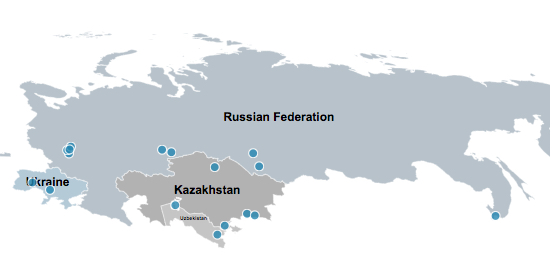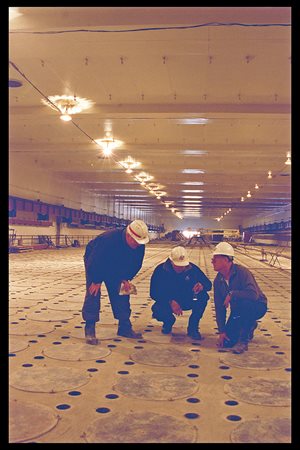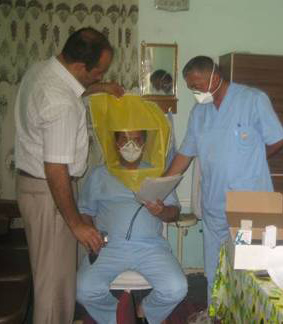To look at it today, the town of Pervomaysk, in Ukraine’s central plains, tucked in a river valley and cut into a familiar grid of farm fields, doesn’t seem any more threatening than hundreds of similar towns across the U.S. Midwest. A waving field of cheery sunflowers obscures the location’s history as one of the world’s biggest nuclear weapons hotspots – literally. In 1996, the defense ministers of Ukraine, Russia and the U.S. planted sunflowers atop the site where a nuclear missile silo had been, marking a new era of peace for the town, the region and the world.
Bechtel’s work in the former Soviet republics

After the fall of the Soviet Union in the early 1990s, Pervomaysk was home to a missile base storing 80 SS-19 intercontinental ballistic missiles in underground silos. These nuclear weapons had an operational range of 10,000 kilometers (6,200 miles) and each one was aimed at, and capable of reaching, the United States. At that time, this danger facing the U.S. and the world was one of many.
Read a guest essay on private-sector weapons destruction by former U.S. Sen. Richard Lugar
By 1992, more than a dozen independent countries emerged in Eastern Europe and Central Asia, bringing a monumental threat with them: 35,000 nuclear weapons were scattered at sites spanning 11 time zones and laboratories across the region were working with 40,000 tons of chemical weapons and a deadly stockpile of biological weapons.
 For more than 25 years, Bechtel was a key player in the historic initiative that eliminated this threat of loosely controlled weapons of mass destruction in the former Soviet Union. The last of the company’s work on that project wrapped up earlier this year.
For more than 25 years, Bechtel was a key player in the historic initiative that eliminated this threat of loosely controlled weapons of mass destruction in the former Soviet Union. The last of the company’s work on that project wrapped up earlier this year.
“The state of the facilities when we arrived was quite shocking,’’ said Barbara Askalany, Bechtel’s project manager for the Biological Threat Reduction program. “There were laboratories working with dangerous materials like anthrax and the plague with unlocked doors and wide open windows.”
Making a Difference
As part of the Nunn-Lugar Cooperative Threat Reduction program created by Congress, Bechtel joined the effort to safeguard nuclear weapons facilities like the one in Pervomaysk, along with biological laboratories throughout the region. Bechtel’s goal was to eliminate the existing threat and reduce the risk of future proliferation.
The first part of the work was to evaluate each facility, working with the local scientists and staff to implement tailored safety and security measures. In biological laboratories, this can involve things as simple as installing air conditioning units – allowing windows to remain shut and locked – and designing laboratory floors that can be easily disinfected. On the nuclear weapons side, work included the dismantlement of ballistic missile silos, launch control centers, and fueling facilities.
Beyond securing existing infrastructure, Bechtel designed and built new facilities. The company built state-of-the art biological research laboratories with proper security measures for dangerous pathogens and the Fissile Material Storage Facility in Russia to safeguard dangerous nuclear material.
“Stand on their own”
 In what Askalany described as the most valuable part of the work, U.S. scientists established curricula and carried out safety training with their foreign counterparts to help these countries sustain the work themselves after the outside contractors departed, and implemented research programs to encourage peaceful research.
In what Askalany described as the most valuable part of the work, U.S. scientists established curricula and carried out safety training with their foreign counterparts to help these countries sustain the work themselves after the outside contractors departed, and implemented research programs to encourage peaceful research.
“The investment in our work would have been to no avail had we not left these nations with the tools and training,” said Mac McNeil, program manager for the Biological Threat Reduction Integrating Contract. “They need to be able to stand on their own as they maintain these capabilities.”
Bechtel’s work on the project was unique in that it required the company to use its expertise in engineering and construction in a new way and in an unfamiliar environment, according to Askalany, with the Biological Threat Reduction program.
“I think it was brave of Bechtel to get into this area and a great opportunity to be a part of something so unique,” said Askalany.
By the numbers
In the end, accomplishments included:
- Eliminating 9 SS-25 missile bases and transporting more than 300 missiles and associated launch vehicles to storage sites in Russia
- Dismantling 130 SS-19 intercontinental ballistic missiles, 13 launch control centers, and associated fueling facilities at two bases in Ukraine
- Dismantling 46 SS-24 ICBM silos, 4 launch control centers, and other facilities at Pervomaysk, Ukraine
- Managing design, construction, and equipment installation at the one-of-a-kind Russian Fissile Material Storage Facility, which stores 25,000 containers of material from dismantled nuclear warheads
- Demilitarizing two rocket fuel component storage facilities, including fuel neutralization; and decontamination, dismantlement, and removal of equipment and structures used to store rocket fuels,
- Completing comprehensive security upgrades of 11 nuclear weapons storage sites in Russia,
- Destroying two of the world’s largest anthrax production facilities, and
- Building or renovating more than 40 biological laboratories, including a Central Reference Laboratory in the Republic of Georgia of more than 8,000 square meters and capable of Biological Safety Levels 2 and 3 research

